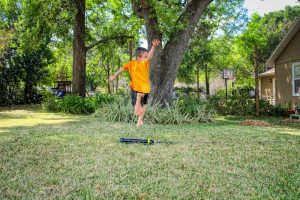As the weather cools and the leaves begin to fall, many homeowners shift their focus to preparing their gardens for winter. However, fall is also one of the most critical times for lawn care. By taking the right steps now, you can ensure a lush, green lawn when spring arrives.
Here are some essential fall lawn care tips to help your grass thrive:
 Keep Mowing (But Adjust Your Height)
Keep Mowing (But Adjust Your Height)
While grass growth slows down in the fall, it’s important to continue mowing your lawn until it stops growing. However, adjust your mower to cut the grass a little shorter in the final mowings of the season. Cutting it to about 2 to 2.5 inches helps prevent disease and leaves less room for fallen leaves to get trapped. Just be sure not to cut it too short, as that can stress the grass.
Rake Fallen Leaves
Fallen leaves, while beautiful, can smother your grass if left unchecked. They block sunlight, trap moisture, and can lead to fungal growth. Regularly rake or mulch the leaves to keep your lawn healthy. If you use a mulching mower, finely chopped leaves can decompose and provide natural nutrients for your lawn.
Aerate the Soil
Fall is an excellent time to aerate your lawn, especially if the soil is compacted. Aeration helps alleviate soil compaction by creating small holes that allow air, water, and nutrients to reach the roots. This encourages deeper root growth and stronger grass. You can rent a core aerator or hire a lawn care professional for this task.
Fertilize for Future Growth
Fertilizing in the fall is one of the most important steps for a lush lawn next spring. A slow-release fertilizer provides essential nutrients that help strengthen grass roots for winter survival. Apply a nitrogen-rich fertilizer in mid to late fall, just before the first freeze. This promotes healthy root growth and gives your lawn a head start when temperatures warm up again.
Overseed Thin or Bare Areas
Fall is the perfect time to overseed your lawn if it has thin or bare spots. Overseeding helps to thicken the grass and reduce weed competition in the spring. Choose a grass seed blend that suits your region and spread it evenly over bare areas. After overseeding, lightly water the lawn to ensure good seed-to-soil contact and promote germination.
Water Your Lawn (But Watch the Weather)
While fall typically brings more rain, it’s important to keep an eye on your lawn’s moisture levels. Grass needs about 1 inch of water per week, including rainfall, to stay healthy. If the weather is dry, continue watering your lawn until the ground freezes. However, avoid overwatering, as cool, wet conditions can lead to fungal issues.
Control Weeds
Weeds, such as dandelions and clover, can steal nutrients and water from your grass. Applying a broadleaf weed killer in the fall is highly effective, as weeds are storing energy in their roots for winter. By eliminating weeds now, you reduce their presence next spring.
Mulch Grass Clippings
Instead of bagging grass clippings, consider leaving them on the lawn after mowing. Clippings act as a natural fertilizer by returning nutrients like nitrogen back to the soil. Just be sure to mulch or mow often enough so that the clippings are small and won’t smother the grass.
Edge and Clean Up Borders
 Fall is a great time to tidy up your lawn edges and garden borders. Define the edges of your lawn, remove any debris, and clear out garden beds. This creates a neat, polished look and sets your yard up for success come spring.
Fall is a great time to tidy up your lawn edges and garden borders. Define the edges of your lawn, remove any debris, and clear out garden beds. This creates a neat, polished look and sets your yard up for success come spring.
With proper fall lawn care, you’ll be setting the foundation for a lush, green lawn that will be the envy of the neighborhood next spring. A combination of mowing, aerating, fertilizing, and overseeding can work wonders to keep your grass healthy throughout the winter. Invest a little time and effort now, and your lawn will thank you with vibrant growth when warm weather returns.



